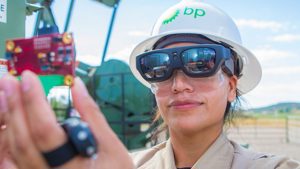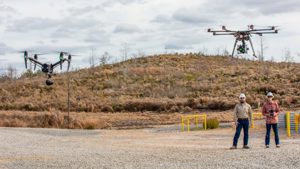Industry-first, continuous methane measurement program
Drones equipped with space-age sensors are part of a wave of advanced technology zooming into operation at BP’s new major oil and gas processing projects as part of a program to continuously measure methane emissions.
The high-tech kit is part of an industry-leading BP program to continuously detect, measure and enable the reduction of methane emissions at new and existing BP-operated Upstream assets. This crackdown on emissions has been made possible by a raft of new and complementary technologies, such as:
- Gas cloud imaging (GCI), tested in the deserts of Oman at BP’s Khazzan tight gas project, allowing constant site monitoring.
- Drones that live stream data, thanks to highly-advanced on-board sensors developed by NASA.
- Smart glasses for field operators using multi-source augmented reality (AR) to enable the wearer to read sensor information on their lenses and communicate in real time with technical experts at a control center.
- Video imaging spectral radiometry (VISR) flare monitors using infrared images to measure how efficiently a flare consumes emissions.
- Hand-held gas leak detectors.
“This program represents an industry first and reflects our commitment to be a leader in advancing the energy transition by maximizing the benefits of natural gas,” says Gordon Birrell, BP’s chief operating officer for production, transformation and carbon.
BP believes that natural gas can play an important role in tomorrow’s lower-carbon energy system. It is abundant, affordable and has half the emissions of coal when burnt for power.
But natural gas is mainly methane. And, if methane escapes into the atmosphere unburnt, it can be a potent greenhouse gas.
“For gas to play its fullest role in the energy transition, we have to keep it in the pipe. This new technology will help us do that by detecting methane emissions in real time. The faster and more accurately we can identify leaks, the better we can respond and, informed by the data collected, work to prevent them,” Gordon Birrell, BP’s chief operating officer for production, transformation and carbon.
The continuous measurement of methane emissions marks a step-change in the industry’s approach to tackling emissions of the potent greenhouse gas.
Measuring methane
Historically, engineering calculations and emission factors have played an important part in quantifying emissions. The proven technology to systematically move beyond that approach hasn’t existed ̶ until now.

BP’s vice president of digital innovation, Morag Wilson, lead the hunt for new technologies. She says: “Many of today’s technological breakthroughs were only aspirations until recently. Three years ago, we sat in a room and brainstormed what we would need to achieve continuous measurement, because, at the time, the technology portfolio needed was not yet fully developed.”
GCI, when combined with other techniques, such as drones and what the industry refers to as ‘methane-sniffing’ technology, is now creating a ‘step-change’ in how BP can operate its new major projects, explains Watson. “As a result, inspections that used to take days will now be able to take 30 minutes,” she says.
BP has already set itself a methane intensity target of 0.2% from its Upstream operations and has held a series of methane roundtables around the world, bringing together experts from academia, NGOs and policy-makers to improve understanding across the industry. On the back of those events, BP set out possible actions and priorities, which have formed the basis of recent progress.







Comments